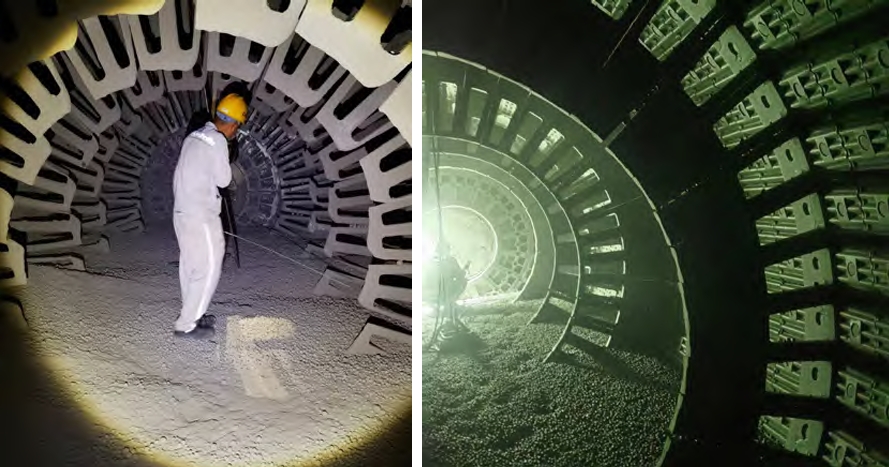Lining plates serve as critical components in concrete mixers, protecting the mixer barrel from direct impact and wear while extending service life and improving operational efficiency. Due to harsh working environments involving abrasive concrete mixtures and corrosive slurries, these lining plates experience severe wear, necessitating frequent replacements that disrupt production. This study employs laser cladding technology to enhance the wear resistance of chromium alloy steel lining plates. Using Fe60 alloy powder as the cladding material, we systematically optimize process parameters, introduce WC reinforcement, design gradient coatings to mitigate cracking, and apply laser remelting to eliminate internal defects.
1. Introduction and Experimental Methods
The base material is chromium alloy steel with chemical composition shown in Table 1. Fe60 alloy powder (45-106 μm) was selected for its cost-effectiveness and compatibility with the substrate, while WC particles (40-80 μm) were added to enhance hardness. Laser cladding was performed using a HAN’S HL-WM-4000 system with argon shielding gas. Key process parameters included laser power (800-1000 W), scanning speed (400-600 mm/min), powder feed rate (7-11 g/min), and overlap ratio (30-50%). Post-cladding analyses included:
- Metallography using DM2700M microscope after polishing and etching with aqua regia.
- Microstructure characterization via SU8010 SEM with EDS.
- Phase identification by X-ray diffraction (40 kV, 300 mA, 20°–90°).
- Microhardness testing (HMV-10S, 1000 g load, 10 s dwell).
- Crack detection using DPT-5 penetrant.
- Wear testing (RTEC-MFT5000, Al2O3 ball, 10 N load, 6 Hz, 40 min).

| C | Si | Mn | P | Ni | Mo | S | Fe |
|---|---|---|---|---|---|---|---|
| 3.76 | 0.53 | 0.35 | 0.018 | 0.012 | <0.01 | 0.027 | Bal. |
2. Optimization of Laser Cladding Process Parameters
Orthogonal experiments (L9(34)) and weighted comprehensive evaluation determined optimal single-track parameters. Dilution rate (η) was calculated as:
$$ \eta = \frac{D}{H + D} \times 100\% $$
where D = melt depth and H = cladding height. Evaluation weights prioritized hardness (5), dilution (3), and surface quality (2). Optimal parameters were: laser power = 900 W, scanning speed = 600 mm/min, powder feed rate = 7 g/min. Multi-track cladding used overlap ratios of 30%, 40%, and 50%. A 50% overlap minimized surface undulations without cracks (Table 2).
| Parameter | Range/Condition | Score |
|---|---|---|
| Microhardness (HV) | 550–599 | 0–2 |
| 600–649 | 3–4 | |
| 650–699 | 5–6 | |
| 700–749 | 7–8 | |
| 750–800 | 9–10 | |
| Surface Quality | Smooth, no pores/cracks | 9–10 |
| Smooth, minor pores | 7–8 | |
| Smooth, minor pores/cracks | 5–6 | |
| Rough, obvious pores/cracks | 3–4 | |
| Rough, severe defects | 0–2 |
The Fe60 cladding exhibited gradient microstructures: equiaxed crystals (top), dendritic crystals (middle), cellular/columnar crystals (bottom), and planar crystals (substrate interface). Average microhardness reached 742 HV (1.8× base material). Wear tests showed a friction coefficient of 0.57 and mass loss of 0.5 mg, outperforming the substrate (0.64, 0.7 mg). Wear mechanisms transitioned from adhesive-abrasive (substrate) to predominantly adhesive (cladding).
3. Gradient Fe60/WC Composite Coating
Adding WC particles (5–15 wt.%) enhanced hardness but induced cracks due to thermal stress (δT):
$$ \delta_T = \frac{E_c (\alpha_m – \alpha_c) \Delta T}{1 – \nu_c} $$
where Ec = elastic modulus, αm and αc = thermal expansion coefficients of substrate and cladding, ΔT = temperature difference, and νc = Poisson’s ratio. A gradient design eliminated cracks at ≤10% WC (Figure 1):
- Layer 1: Fe60 transition layer.
- Layer 2: Fe60/WC top layer (5%, 10%, or 15% WC).
XRD identified α-Fe, γ-Fe, M23C6 (M=Fe, Cr), and WC phases. WC dissolution promoted Fe3W3C3 formation at higher concentrations. EDS confirmed WC-derived W segregated in interdendritic regions (Figure 2). Grain refinement occurred via:
- Increased undercooling around high-melting-point WC particles.
- Dislocation generation from thermal expansion mismatch.
- Dendrite growth inhibition by WC.
| WC Content | Avg. Microhardness (HV) | Hardness Multiplier vs. Substrate |
|---|---|---|
| 0% | 708.0 | 1.71× |
| 5% | 744.2 | 1.81× |
| 10% | 822.1 | 2.00× |
| 15% | 851.5 | 2.06× |
The 10% WC coating achieved optimal balance: hardness = 822.1 HV, friction coefficient = 0.518, and wear loss = 0.3 mg (57% reduction vs. substrate). Adhesive wear dominated due to “hard-soft” microstructure.
4. Laser Remelting of Gradient Coatings
Laser remelting (400–500 W, 600 mm/min) sealed pores in the 10% WC gradient lining plate coating. At 450 W, surface smoothness improved without cracks. Remelting induced:
- Further WC decomposition and W diffusion (EDS in Table 4).
- Denser equiaxed grains and reduced dendrite size.
- Stronger XRD peaks for M23C6 and Fe3W3C3.
| Element | Spectrum 1 | Spectrum 2 |
|---|---|---|
| C | 8.13 | 10.72 |
| Fe | 61.27 | 75.74 |
| Cr | 16.29 | 7.67 |
| W | 14.30 | 4.17 |
Microhardness increased to 857.6 HV (2.1× substrate). Wear performance improved significantly: friction coefficient = 0.454 (32% lower than substrate), wear loss = 0.1 mg (85.7% reduction). Shallower wear grooves confirmed enhanced adhesive wear resistance.
5. Conclusions
- Optimal single-layer Fe60 cladding for lining plates used laser power = 900 W, scanning speed = 600 mm/min, powder feed rate = 7 g/min, and 50% overlap. Microstructure transitioned from equiaxed (top) to planar crystals (interface). Hardness reached 742 HV with 29% lower wear loss than the substrate.
- Direct WC addition (≥5%) caused cracking due to thermal stress. A gradient design (Fe60 transition + Fe60/WC top) enabled crack-free incorporation of 10% WC. W segregation refined grains, increasing hardness to 822.1 HV and reducing wear by 57%.
- Laser remelting (450 W) eliminated pores in 10% WC coatings. Enhanced grain uniformity and hard-phase distribution increased hardness to 857.6 HV. Friction coefficient dropped to 0.454 with 85.7% less wear than the substrate.
This methodology extends lining plate service life in concrete mixers, reducing maintenance costs and downtime. Future work will explore industrial validation and corrosion resistance.
